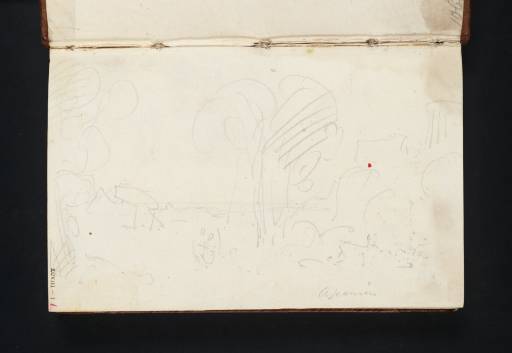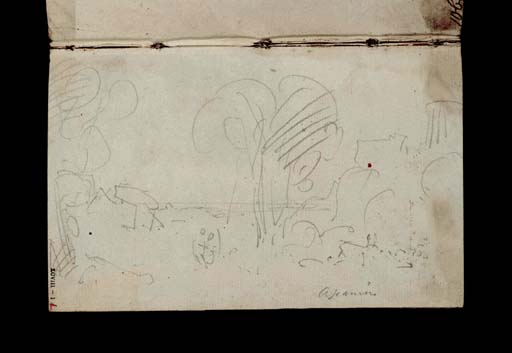Joseph Mallord William Turner Ascanius Shooting the Stag of Silvia 1805
Image 1 of 2
Joseph Mallord William Turner,
Ascanius Shooting the Stag of Silvia
1805
Joseph Mallord William Turner 1775–1851
Folio 1 Recto:
Ascanius Shooting the Stag of Silvia 1805
D06180
Turner Bequest XCVIII 1
Turner Bequest XCVIII 1
Pencil on white laid paper, 117 x 182 mm
Inscribed by Turner in pencil ‘Ascanius’ lower right of centre
Inscribed John Ruskin in red ink ‘1’ bottom left, descending vertically
Stamped in black ‘XCVIII 1’ bottom left, descending vertically
Inscribed by Turner in pencil ‘Ascanius’ lower right of centre
Inscribed John Ruskin in red ink ‘1’ bottom left, descending vertically
Stamped in black ‘XCVIII 1’ bottom left, descending vertically
Accepted by the nation as part of the Turner Bequest 1856
References
1909
A.J. Finberg, A Complete Inventory of the Drawings of the Turner Bequest, London 1909, vol.I, p.253, XCVIII 1, as ‘Study for historical picture, “Ascanius”’.
1990
Kathleen Nicholson, Turner’s Classical Landscapes: Myth and Meaning, Princeton 1990, pp.265 reproduced, 276–7.
1990
Andrew Wilton and Rosalind Mallord Turner, Painting and Poetry: Turner’s ‘Verse Book’ and his Work of 1804–1812, exhibition catalogue, Tate Gallery, London 1990, p.125.
1993
David Hill, Turner on the Thames: River Journeys in the Year 1805, New Haven and London 1993, p.167, as ‘Claudian Composition of Figures in an Italianate Landscape with a Distant View of the Sea, Classical Building on a Hill to the Right: Ascanius (Son of Aeneas – Virgil, ‘Aeneid’).
2001
Martin Butlin, ‘Carthage and the Story of Dido and Aeneas’, in Evelyn Joll, Martin Butlin and Luke Herrmann eds., The Oxford Companion to J.M.W. Turner, Oxford 2001, p.43.
This very slight outline sketch is one of two in this sketchbook illustrating the Aeneid; see Introduction to the sketchbook and folios 1 verso–2 (D06181–D06182). The story of Aeneas’s son Ascanius is told in Book 7, 483–99. In Virgil’s version, which is only one of various narratives,1 Ascanius was the son of Aeneas by the Trojan, Creusa. After the fall of Troy, father and son escape to Italy where Ascanius provokes a war between the Trojans and the Latins by wounding a pet stag belonging to Silvia, the daughter of the royal herdsman.
In Tuner’s sketch Ascanius, with another figure, is seen at centre, drawing a bow to shoot the stag, visible at right. The setting of a classical landscape near the coast, with architecture, is reminiscent of Claude Lorrain, both of his last painting, Landscape with Ascanius Shooting the Stag of Silvia (Ashmolean Museum, Oxford) and the earlier Coast of Libya with Aeneas Hunting (Musées Royaux des Beaux-Arts, Brussels). Noting these similarities, Nicholson observes that the subject ‘provided exactly the kind of irony-laden moment set out-of-doors in a wooded landscape that Turner preferred’, but that he did not pursue it further than this sketch.2
David Blayney Brown
July 2008
How to cite
David Blayney Brown, ‘Ascanius Shooting the Stag of Silvia 1805 by Joseph Mallord William Turner’, catalogue entry, July 2008, in David Blayney Brown (ed.), J.M.W. Turner: Sketchbooks, Drawings and Watercolours, Tate Research Publication, December 2012, https://www


